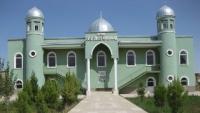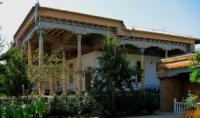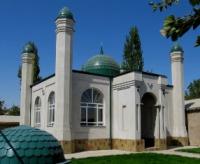You are here
Sights in Istaravshan.



Main sights Istaravshan.
This city (formerly Ura-Tyube, Uroteppa) is situated northwest of Tajikistan, 73 km near Khojent. The town is one of the most ancient urban settlements in Central Asia, dating back to the first millennium BC.
The recorded history of Istravshan dates back to VI century BC when the region was a province of the Persian Empire under the Achaemenids. Scholars may recognize the region under its classical name of Kiropol, as described by Strabo (Kiraskhata, according Ptolemy, Kurukada in Persian and Kurushkada in Sogdian languages).
It was fortified by three rows of walls and the citadel was surrounded by wall 6,000 m long. From the 2-1st centuries BC to the 1-2nd centuries AD, much of what is now Istravshan was known as Ustrushana, the capital of which was Bunjikat.
It was a trading center and benefited greatly from its position as an important staging post on the commercial roads that linked the civilizations of East and West, through Khojent, Samarkand, Bukhara and the Ferghana Valley.
In the epoch of the Arab invasion (Istravshan became a province of the Arabian Caliphate in 822 AD), the region became a commercial and cultural center of the medieval East. Muslim ideology and religion blended with local traditions to develop new types of structures (the mosque, madrasa, mausoleum, minaret).
The specific features of these buildings developed on the basis of progress made in portal and vaulted structures. Istravshan lived undisturbed until the 13th century AD when the Mongols laid waste to the towns and slaughtered its habitants.
The population resisted the invasion and fought fiercely. Like many cities of Central Asia, Istravshan was turned into ruins. The irrigation system was destroyed, making a number of settlements uninhabitable.
After that, Istravshan reappeared in the XIVth century as Ura-Tyube. In the late part of this century came a period of unprecedented cultural blossoming in Mawarannahr, when Samarkand was made the capital of a vast empire under the Mongol prince, Timur.
Uroteppa and its districts became a part of this new state. The town Ura- Tyube was densely populated, with dwellings built in blocks. The population was supplied with water by open canals (aryks), underground pipes and wells.
In each quarter, open water pools and closed water reserves were constructed, partly to give easy access to water but also to create a refreshing environment. In the XVIth century the head of the Shaybani clan (the forefathers of the Uzbeks), in federation with the Turkish- Mongolian tribes, conquered Mawarannahr and occupied the still rich Syrdarya Valley.
They founded the Uzbek State, with the capital at Bukhara that became a political and cultural center, the bulwark of Sunni Islam learning and the safe-keeper of its shrines. But Central Asia lost much of its importance and prestige at this time. It was cutoff from Iran, India and the sea.
Transit trade from India to the west was monopolized by the other states. In XVIIIlh century, the citadel and walls of Ura-Tyube were fortified against invaders who attacked repeatedly. The town then occupied 527 hectares including an ancient citadel with dwellings, mosques, madrasas, 6 washing baths, and many teahouses (chaykhanas).
Ura-Tyube preserved its independence for fifty years until the beginning of the XIXlh century. The Ura- Tyube viloyat (region) went through a limited recovery and independence. Khudayar Wallami domed mausoleum stands in the grave complex Khazrati Shah (Lenin Str. 98).
Local people consider that Kusam ibn Abbas, a cousin of the prophet Muhammad, was buried in this complex too. A modest double domed building the mausoleum was composed of a sepulchre (дигкһапа) and a chapel (zyaratkhana).
The pool, which is fed by an underground spring, has developed into a compositional element of the architectural ensemble. The decoration combines traditional planning with folklore-style decorative paintings.
Very often bath houses (hammom) were built near mosques because they were used not only as bathing-places, but also for ritual washing before prayer. They were constructed from burnt bricks.
The washing rooms were covered by water-proof stucco and had cupolas. There was a special room for rest and tea. People gathered at the bath houses to talk, play chess, have their hair cut, etc.
There were bath houses in every block of Ura- Tyube (Kordgaron, Darvoza-i Bolo, Havzi-Moron, etc.) Modern Istravshan (formerly Ura- Tyube) is a town of craftsmen. Until recently they lived in specific quarters (guzars) of weavers, potters, braziers, smiths and so on.
Wonderful pieces of carving, remnants of decorative clothes, painting, pottery, mural paintings, jewelry, embroidery, and pottery of burnt clay glazed with calligraphy are the evidence of the high interest people took in art and handicrafts. Pottery in Istravshan was usually made by men.
The range of objects made by the potters was very wide and included dishes of various sizes and shapes, cups, diverse earthenware jars, bowls, washbasins and jugs. Metal work-copper and bronze chasing - was concentrated in Istravshan since ancient times.
The smith’s and silversmith’s trade was highly honored, with the forge and especially the anvil held sacred. Masters used metal to decorate jugs for water and tea, wash-hand-basins, trays, various bowls, plates and big copper pails.
In Istravshan, jewelry was traditionally part of the national dress and a woman’s life-long companion. There were quarters of metal smiths (zargar) that produced different pendants for necklaces, head ornaments and bracelets.
The silver and gold diadem for women qoshtillo, meaning “golden eyebrows”, was popular. Hair and ear ornaments were also favorites. Frequently, women’s plaits were interlined with black silk or cotton cords terminating in long tassels, which were decorated with engraved silver and/or pendants of coral and turquoise.
Typical of Istravshan earrings are short ornaments of various forms. Although many of the memorials of Istravshan have long been razed, those that remain show the cultural legacy of a city that was once an indispensable part of world civilization.
These monuments have outlived the glory of the rulers of Istravshan, but every stone bears traces of the past. Much of the architecture and handicrafts of the past are preserved in the town.
The hill to the northeast of town, just near the "Istravshan” Hotel is Mug Tepa. The imposing gate at the top of the hill was actually built in 2002 during Istravshans’s 2500lh anniversary celebration.
At the foot of the hill is the Regional Museum. Istravshan’s bazaar is one of the biggest in the region. Six kilometers from Istravshan there is a Kattassai Reservoir, a favorite place of recreation of the townspeople. Near to reservoir there is a sanatorium, and several holiday centers.
Istravshan can easily be done in day trip from Khojent or as an overnight stop en route to/from Dushanbe. Shared taxi to Istravshan leave from the old bus station at Kosmonavtov Str. From Istravshan to Khojent transport goes from the bus station 3 km north of the center, and some also go from the stand in front of the bazaar.
Hotel “Istravshan” at Lenin Str. 80. The transport stand for Dushanbe (270 km, 10 - 11 hours), Ayni (110 km, 4 - 5 hours) and Penjikent (190 km, 8 - 9 hours) is situated about 1 km south of the bazaar. Hotel “Istravshan” at Lenin Str. 80.
Authorship:
The Tourist guidebook on monuments of Tajikistan. 2012.







